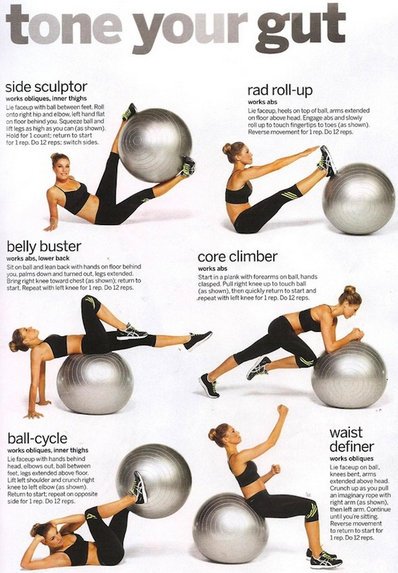Rectus abdominis is popularly known as the abs muscle. It is a pair of long and flat muscle extending vertically along the entire length of the abdomen just near the umbilicus.
The muscles have string of four fleshy muscular bodies that are joined by narrow bands of tendon. It gives the muscles a lumpy appearance when tensed and defined. It is the reason why the rectus abdominis muscle is called six-pack abs. Rectus abdominis are Latin words which means straight and abdominal. (1)
Rectus Abdominis Anatomy
Rectus abdominis muscle extends inferiorly from the pubic crest, pubic symphysis, and pubic tubercle. It surpasses the metastenum. The muscle inserts into the fifth, sixth, and seventh ribs of the costal cartilages by three different parts.
Origin and Insertion

Tent of the muscles, especially during contractions. Three bands of connective tissues crossed the rectus abdominis. It is called the tendinous intersections, which is situated just at the umbilicus level. he rectus sheath encloses the flat muscles and hold the muscle in place. It does not restrict the movem
Rectus abdominis is a Mathes and Nahai Type 3 muscle, which has two dominant pedicles. It has a rich supply of arterial blood vessels and consists of 53.9% type 2 fibers. The upper portion of the muscle contains blood from the superior epigastric artery. (3)

Image 1 : Rectus abdominis muscle
Photo Source : www.mindandmuscle.net
Muscle Anatomy video

Picture 2 : Crunching exercises to significantly improve the appearance and strength of the rectus abdominis muscle
Image Source : media-cache-ak0.pinimg.com

Figure 3 : A woman performing rectus abdominis muscle exercises using a stability ball.
Picture Source : positivemed.com
What is the function and action of the Rectus Abdominis Muscle?
Rectus abdominis muscle helps in various bodily functions. Some of the notable functions of the rectus abdominis muscle include the following:
- It helps human in maintaining proper posture.
- It helps in activities that involve flexing of the lumbar region of the vertebral column such as performing abdominal exercises like crunches. (2)
- It aids in breathing and respiration, especially when it comes to forced exhalation after performing an exercise.
- It can stretch the abdominal wall and at the same time compresses the abdominal contents. The compression of the abdominal cavity is useful in emergency situations such as the Valsalva maneuver. (4)
- It helps stabilize the pelvis to allow the lower limb muscle to work properly.
- It controls the tilt of the pelvis during contraction. (3)
- It helps in flexing the spine to the front down and forward towards.
- It helps in the flexion of the thoracic spine and lumbar spine.
What is the Rectus sheath?
The rectus sheath contains the rectus abdominis and the pyramidalis muscles. It is the fibrous condensation of the aponeurotic layers (shiny white tendons) on the anterior portion of the abdominal wall. Aside from the rectus abdominis, the sheath also contains the epigastric vessels, subcostal and intercostal vessels and nerves. (7)
Injury involving the Rectus Abdominis Muscles
The rectus abdominis muscle is prone to injury or damage, especially during extreme workout. Athletes usually experience muscle strain of the abdomen. The muscles of the abdomen can be ruptured or torn depending on the severity of the injury. There will be a notable pain and discomfort in the abdominal area because of the injury.
There are instances when a person will suffer from aggressive fibromatosis or also known as desmoids tumors in the right rectus muscle. The tumor can be detected through a CT scan or MRI scan image. A person may also suffer from a condition called Diastasis Rectus Abdominis (DRA), which causes the rectus abdominis muscles to separate into half. Common symptoms for DRA include epigastric hernia. Some medical reports showed a possibility of endometriosis of the rectus muscle. (3)
Rectus abdominis strain is one of the common conditions and caused by overstretching of the muscle. People who perform strenuous exercises have the tendency to experience rectus abdominis strain. To prevent muscle strain, you should warm up prior to exercising.
Do not forget to cool down afterwards. You should avoid sudden twisting motions as well as lifting too heavy objects. Rectus abdominis injury is common to swimmers, weight lifters, and those playing hockey and skating. It is also common to overweight people. (8)
Levels of injury to the Rectus Abdominis Muscles
- First-degree strain – The rectus abdominis is abnormally stretched but is still intact.
- Second-degree strain – There is a severe stretching of the muscle that resulted to a partial muscle tear.
- Third-degree strain – There is a complete tear of the rectus abdominis muscle to the point that the muscle separates from the tendons. There is a possibility that the patient will develop a hernia (an abnormal protrusion of the intestines and connective tissues through the rectus abdominis and other muscles in the abdomen.
What are the symptoms of Rectus Abdominis strain?
- Pain in the abdominal muscle area after performing vigorous activities like running, striking a ball, and prolonged sitting.
- Pain while coughing, laughing, or sneezing.
Recommended Rectus Abdominis workout : Exercises
There are exercises you can do to significantly improve the appearance and functions of the rectus abdominis muscles. These are the following:
- Sit-ups – This exercise aims to strengthen the rectus abdominis muscle. It is a simple exercise that is beneficial not just to the rectus abdominis but to other muscles of the body. Lye on your back with your knees bent. Your hand should be behind your head as you are carefully lifting your shoulder blades off the floor. You won’t need any exercising tools or equipment to perform sit ups. The principle is to basically rely to the weight of your body.
- Stability ball – This exercise provides unstable surface for the rectus abdominis training. Using the stability ball, you can perform a variation of exercises such as sit-ups while on the ball. It enables you to lower your upper body beyond a parallel position to significantly increase the movement during abdominal training. Using the stability ball, lie face down on the ball and place your hands on the floor with your arms straight. Put your hands away from the ball until the ball sits against your shins. Tuck by bending the knees and keep the gently roll the ball towards your chest.
- Static/Non-movement contractions – It strengthens the rectus abdominis. You can perform this exercise while sitting or even lying down. Just tighten your stomach by pulling the navel towards the spine.
- Planking – This exercise helps in strengthening the core. Planking for a few seconds daily will make a huge difference in your rectus abdominis muscle. (8)
References:
- www.innerbody.com
- www.reference.com
- http://www.patienthelp.org
- http://www.shapesense.com
- http://thewellnessdigest.com
- www.betterhealth.vic.gov.a
- www.kenhub.com
- http://www.livestrong.com
